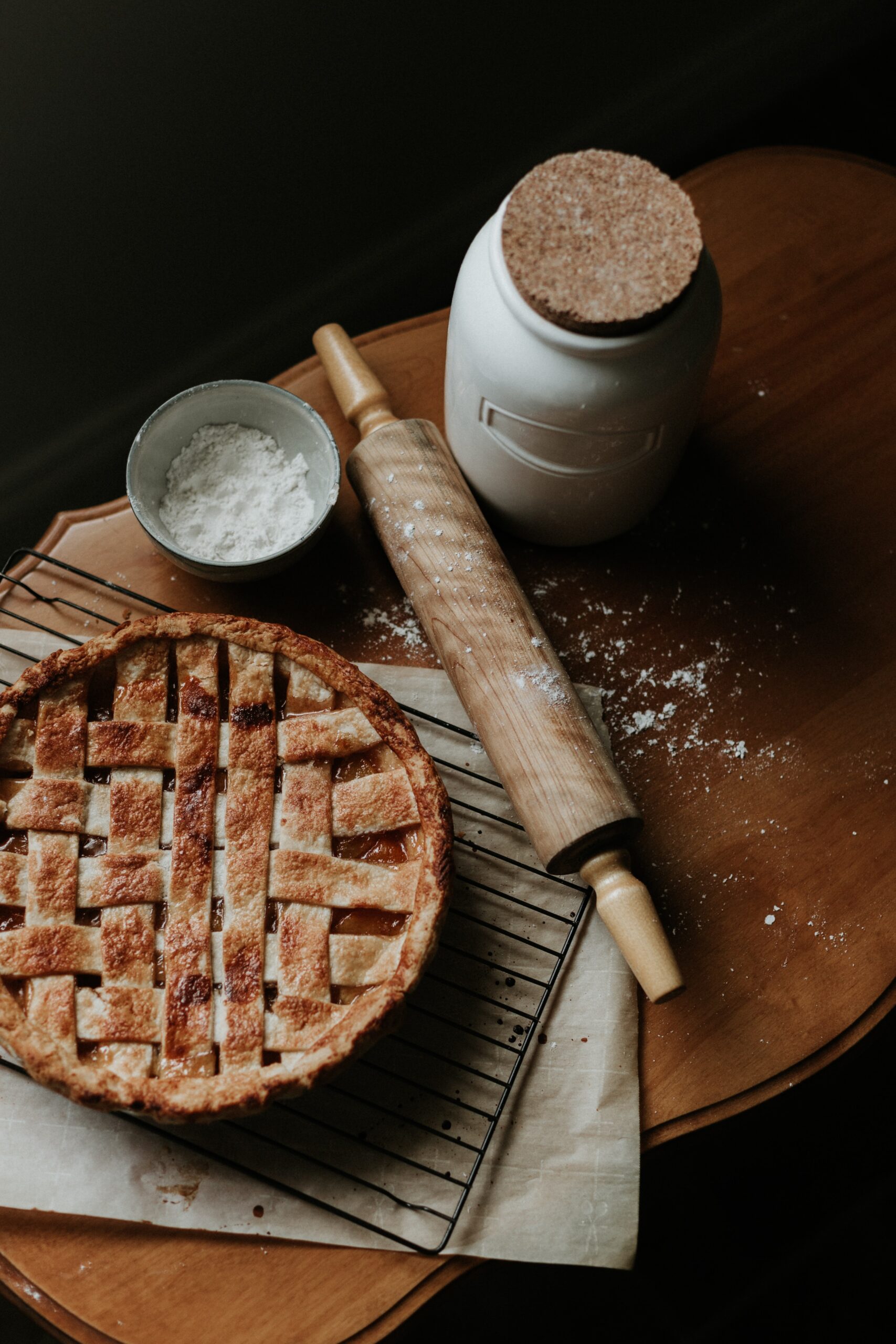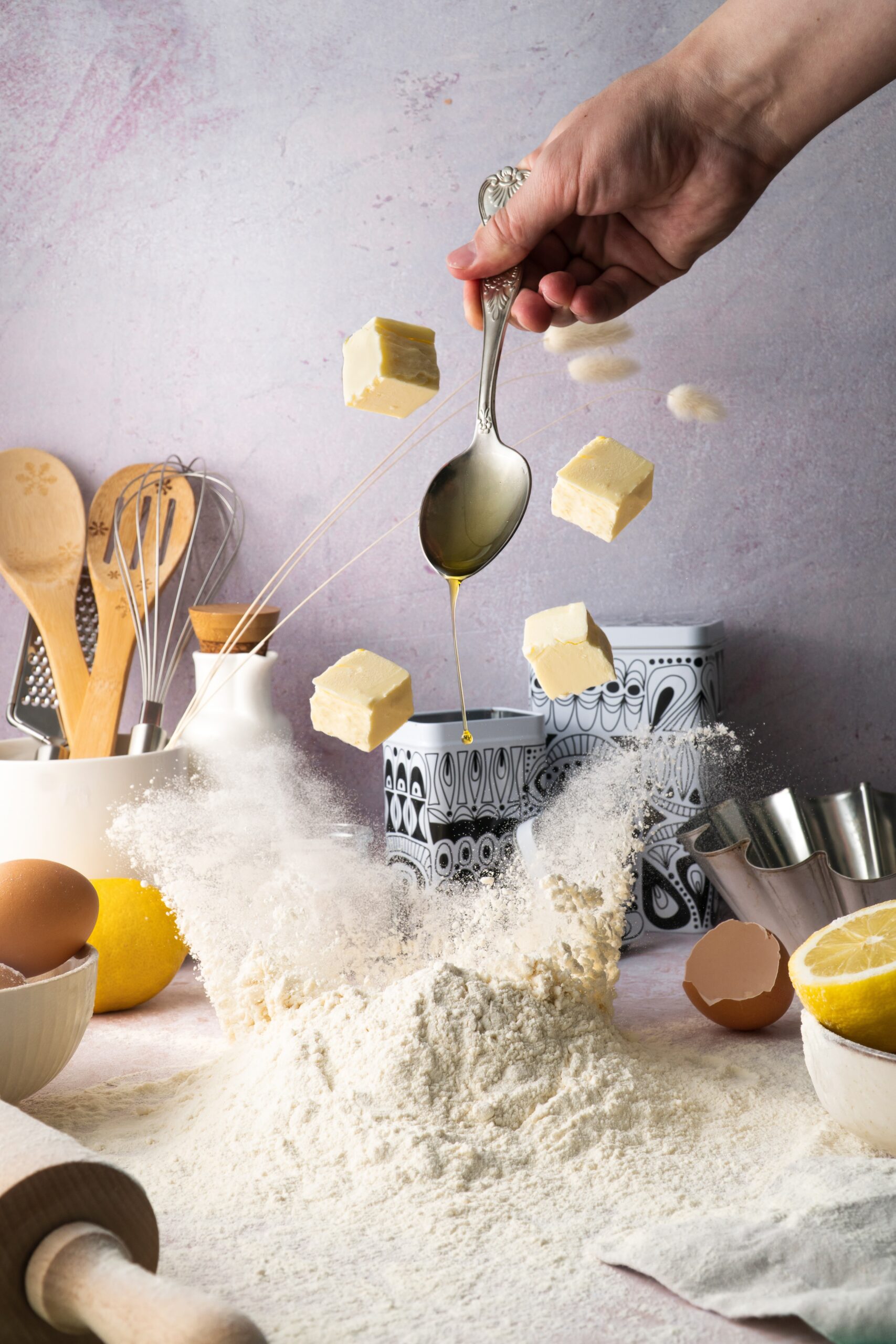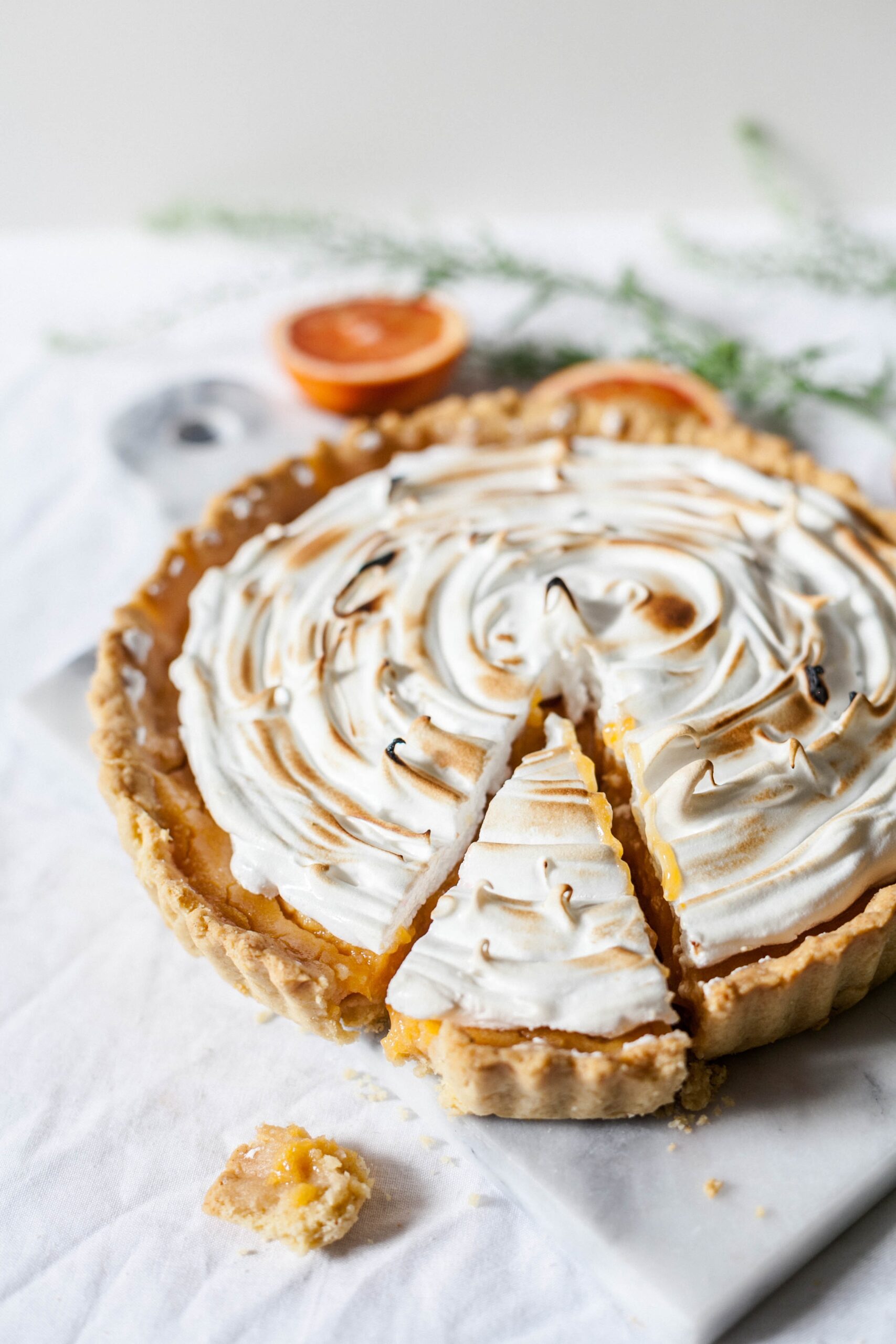This post is all about baking terms 101.
Baking is a wonderful and creative hobby. It allows you to make delicious treats for yourself, your family, and your friends. But if you are new to baking, you may feel overwhelmed with the different baking terms used in recipes and instructions.
Here’s a comprehensive list of baking terms 101 that will help you get started and make your baking journey easier.
All-Purpose Flour
All-purpose flour is a type of wheat flour that is commonly used in baking because of its versatility. It’s made by grinding hard and soft wheat varieties together, which gives it a moderate protein content, usually around 10-12%.
Self-Rising Flour
Self-rising flour is a type of flour that is pre-mixed with baking powder and salt. When it is used in a recipe, there is no need to add additional baking powder or salt.
It is a convenient option for baking quick breads, biscuits, and other baked goods that require a leavening agent. It simplifies the ingredient list and saves time.
Baking Powder
Baking powder is a type of leavening agent used in baking to help baked goods rise. It is a dry chemical mixture that typically contains a combination of baking soda and cream of tartar. It also contains neutral starch, such as cornstarch.
The baking soda reacts with an acidic ingredient, such as buttermilk or vinegar, to create carbon dioxide gas, which causes the batter or dough to rise.
Baking Soda
Baking soda is a leavening agent that is used in recipes that contain acidic ingredients, such as buttermilk, yogurt, or vinegar.
It is an alkaline substance that, when combined with an acid, produces carbon dioxide gas, which causes the batter or dough to rise. The carbon dioxide gas bubbles expand in the heat of the oven, creating a light and airy texture in the finished product.
Yeast
Yeast is a type of fungus that is used in baking to help bread dough rise. It is a single-celled microorganism that ferments the sugars in the dough, producing carbon dioxide gas as a byproduct.
The gas gets trapped in the gluten structure of the dough, causing it to rise and expand during the baking process. This creates a light and airy texture in the finished bread.
Active Dry Yeast
Active dry yeast is a type of yeast that is commonly used in baking, particularly for making bread. It is made up of dehydrated yeast cells that have been placed in a dormant state. It means that they are not actively fermenting.
The yeast cells are covered in a protective coating. It helps to keep them alive and viable for an extended period of time.
Instant Yeast
Instant yeast can be added directly to the dough without needing to be activated first. It’s also known as rapid-rise yeast. Unlike active dry yeast, instant yeast is not dehydrated and is therefore in an active state.
Instant yeast is processed in a way that allows it to be more finely granulated and faster-acting than active dry yeast.
Butter
Butter is a dairy product that is commonly used in baking for its flavor and texture. It is made by churning cream or milk until the fat solids separate from the liquid. This results in a creamy, yellowish-colored solid.
Butter is a key ingredient in many baked goods, including cakes, cookies, and pastries.
Margarine
Margarine is a non-dairy alternative to butter that is commonly used in baking. It is made from vegetable oils, such as soybean, palm, or canola oil, that have been hydrogenated to create a solid form.
Like butter, margarine is used to add flavor and texture to baked goods.
Shortening
Shortening is a type of fat that is commonly used in baking for its texture and flavor. It is made from hydrogenated vegetable oil, typically from soybean or cottonseed oil, which gives it a solid consistency at room temperature.
Shortening is often used in baking recipes to create a tender and flaky texture, especially in pie crusts and other pastries.
Sugar
Sugar is a common sweetener used in baked goods to add sweetness and flavor. It is a carbohydrate that is naturally found in many foods, including fruits and vegetables.
In baking, granulated white sugar is the most commonly used type, but brown sugar, powdered sugar, and other types of sugar can also be used depending on the recipe.
Brown Sugar
Brown sugar is a type of sugar that is commonly used in baking and contains molasses. It is made by mixing white granulated sugar with molasses, which gives it a distinctive brown color and a slightly caramel-like flavor.
The amount of molasses used in the mixture can vary, which affects the flavor and texture of the brown sugar. Light brown sugar has less molasses and a lighter color and flavor, while dark brown sugar has more molasses and a darker color and richer flavor.
Powdered Sugar
Powdered sugar, also known as confectioners’ sugar or icing sugar, is made by grinding granulated sugar into a very fine powder and then adding a small amount of cornstarch to prevent caking. It’s commonly used in frostings, glazes, and other sweet toppings as it dissolves easily and provides a smooth texture.
Because it’s so fine, it’s also used for dusting cakes, cookies, and other baked goods with a fine layer of sweetness. Powdered sugar can also be used to sweeten whipped cream, stabilize egg whites in meringues, and thicken glazes.
Vanilla Extract
Vanilla extract is a liquid flavoring made by macerating and percolating vanilla beans in a solution of water and alcohol. It’s a common flavoring agent in baking due to its distinctive sweet and floral taste, which pairs well with a variety of other ingredients.
Vanilla extract is used in a wide range of baked goods such as cakes, cookies, and pastries. It can also be added to custards, ice creams, and other desserts to provide a rich and creamy taste.
In addition to its flavor, vanilla extract can also be used for its aroma and as a natural remedy for a variety of health issues, including anxiety and inflammation.
Almond Extract
Almond extract is a concentrated flavoring made by soaking crushed almonds in alcohol. It’s commonly used in baking and cooking to add a rich and nutty flavor to recipes.
Almond extract can be used in a wide variety of baked goods, such as cakes, cookies, and breads. It pairs well with other flavors, such as chocolate, fruits, and spices, and can add depth and complexity to many different types of dishes.
Almond extract is also a popular ingredient in confections and desserts, such as marzipan and macarons. When using almond extract in a recipe, it’s important to measure carefully as the flavor can be quite strong and overpowering if too much is added.
Milk
Milk is a common liquid used in baking for its ability to provide moisture and flavor to baked goods. It is often used in recipes such as cakes, cookies, and breads. Milk can also add richness to certain baked goods, such as custards and puddings.
Heavy Cream
Heavy cream is a dairy product that contains at least 36% milk fat. It is used in baking to add richness, moisture, and texture to recipes.
Heavy cream can be used to make whipped cream, pastry cream, and ganache, and it can also be used as an ingredient in cakes, pies, and other baked goods. Because of its high-fat content, heavy cream should be used in moderation in recipes, as using too much can result in a greasy or heavy texture.
When a recipe calls for heavy cream, it’s important to use the correct type of cream, as using a substitute like milk or half-and-half may result in a different texture or consistency.
Buttermilk
Buttermilk is a type of milk that is slightly acidic, which makes it a great ingredient in baking. It is often used in recipes to add a tangy flavor to baked goods such as cakes, muffins, and biscuits.
In addition to its flavor, the acidity in buttermilk can help activate baking soda, which is also an acidic ingredient, to help leaven the dough or batter. Buttermilk can also help tenderize baked goods by breaking down the gluten in flour.
Eggs
Eggs are a common ingredient in baking because of their unique properties. They add moisture to baked goods, which can help to prevent them from drying out during baking.
Eggs also provide flavor, adding richness and depth to baked goods. In addition, eggs contribute to the structure of baked goods. The proteins in egg whites coagulate when heated, helping to hold baked goods together and giving them a light, airy texture.
The fat and emulsifiers in egg yolks help to tenderize baked goods and make them moister. In some recipes, eggs also act as a leavening agent, helping baked goods to rise. Overall, eggs are a versatile ingredient that plays many important roles in baking.
Room Temperature
Room temperature refers to the temperature at which ingredients, typically butter, eggs, and other dairy products, are stored before being used in baking. When ingredients are at room temperature, they are easier to mix together and result in a more even texture in the final baked good.
This is especially important for ingredients like butter, which can become difficult to work with if they are too cold, resulting in an uneven texture and inconsistent baking. It’s generally recommended that ingredients like butter and eggs be left out at room temperature for at least 30 minutes before being used in a recipe.
Preheat
Preheating is the process of heating an oven to a specified temperature before placing food inside to bake or roast. This is an important step in baking as it allows the oven to reach the desired temperature, ensuring that the food cooks evenly and consistently.
Preheating also helps activate the leavening agents in baked goods, like baking powder and baking soda, which help them rise. The time it takes to preheat an oven can vary based on the type of oven and the desired temperature.
Dough
Actually, the dough is a mixture of flour, liquid, and other ingredients, such as yeast, sugar, salt, and fat, that is kneaded or mixed together to form a cohesive mass. The dough can be used to make various baked goods such as bread, pizza crust, pastries, and cookies.
The consistency of dough can vary depending on the recipe, with some doughs being soft and sticky, while others are firmer and easier to handle. Once the dough has been mixed and kneaded, it is typically left to rise before being shaped and baked.
Batter
Batter is a mixture of flour and other ingredients that is pourable and used in baking to make various baked goods like cakes, pancakes, waffles, and muffins. The consistency of the batter can vary depending on the recipe, and it can be thick or thin.
Batters are usually made by mixing dry ingredients like flour, sugar, and baking powder with wet ingredients like eggs, milk, and oil. The mixture is then stirred until it is smooth and free of lumps.
Batters can be flavored with a variety of ingredients like vanilla extract, cocoa powder, or fruit purees to create different flavors and textures. Once the batter is prepared, it can be poured into a baking pan or onto a griddle, and then baked or cooked until it is fully cooked and ready to serve.
Whisk
A utensil used to mix ingredients together is commonly referred to as a “mixing bowl.” It is typically made of a material such as glass, ceramic, or stainless steel and comes in a variety of sizes.
Mixing bowls are an essential tool in baking and cooking, as they allow for the easy mixing of ingredients and can also be used for storing and serving food. Additionally, mixing bowls often have a non-slip base or handle to make them more stable and easy to handle during use.
Fold
Folding is a gentle mixing technique that is commonly used in baking to combine delicate ingredients, such as whipped egg whites or whipped cream, with heavier mixtures. The goal of folding is to incorporate the ingredients together while maintaining as much air as possible in the mixture.
To fold, use a rubber spatula to cut through the center of the mixture and bring the bottom up over the top, then gently rotate the bowl and repeat. The motion should be smooth and deliberate, but not too forceful, as too much mixing can cause the mixture to lose its lightness and rise less in the oven. The process is usually repeated until the ingredients are just combined.
Knead
Kneading is a technique used in baking to develop gluten in dough. When dough is kneaded, it is pressed, stretched, and folded in a repetitive motion, which helps to align the proteins in the flour and create gluten strands. The more gluten that is developed in the dough, the more elasticity and structure it will have, which is essential for certain types of bread and other baked goods.
Kneading can be done by hand, with a mixer, or in a food processor, and the length of time needed will depend on the recipe and the type of dough being made.
Proof
The process of allowing the dough to rise is called “proofing” or “fermenting.” After the ingredients are mixed and kneaded, the dough is left in a warm, draft-free place to rise. During this time, the yeast in the dough consumes the sugars and produces carbon dioxide gas, which causes the dough to rise and become light and fluffy.
Proofing times can vary depending on the recipe and the temperature of the room, but it typically takes 1-2 hours. After the dough has been proofed, it can be shaped and baked.
Score
The technique you are referring to is called scoring. Scoring is the process of making shallow cuts on the surface of bread dough before baking. This helps control the expansion of the dough as it rises and bakes, and creates an attractive pattern on the finished loaf.
Scoring also allows steam to escape from the dough, which helps to form a crisp crust. The cuts can be made with a sharp knife or a special tool called a bread lame. Different scoring patterns can be used to create different effects on the finished loaf, such as a rustic look or a decorative design.
Crumb
The interior texture of a baked good refers to its crumb. The crumb can be described as the structure and texture inside a bread, cake, or other baked good. The crumb of a baked good is influenced by many factors, including the ingredients used, the mixing and shaping techniques, and the baking method.
A good crumb should be evenly distributed, have a pleasing texture and flavor, and should be appropriate for the type of baked good being made. For example, a loaf of bread might have a dense crumb that is perfect for sandwiches, while a cake might have a light and fluffy crumb that is ideal for layering with frosting.
Crust
The outer layer of a baked good is called the crust. This can refer to the browned and slightly crispy exterior of bread, the golden surface of a pie or tart, or the crispy layer on top of a casserole.
The crust is formed during baking as the surface of the dough or batter is exposed to heat and begins to dry out and develop a complex flavor and texture. Different types of crusts can be achieved through various baking techniques, such as brushing the surface with egg wash or milk, or using steam to create a shiny and crisp exterior.
Glaze
This mixture is known as a glaze. It can be made with a variety of liquids, such as water, milk, cream, or fruit juice, and is mixed with powdered sugar to create a smooth, pourable mixture. A glaze is often used to add a sweet and shiny finish to baked goods, such as cakes, cookies, and pastries, and can be flavored with extracts, spices, or other ingredients to enhance the taste.
It can also be used to help toppings, such as nuts or sprinkles, adhere to the surface of the baked goods.
Frosting
Buttercream is a mixture of butter and powdered sugar that is used to decorate and frost baked goods such as cakes and cupcakes. The butter and sugar are creamed together until light and fluffy, and then other flavorings such as vanilla extract or milk can be added to create the desired taste and texture.
Buttercream can be used for both filling and frosting and can be piped in various designs and patterns to decorate cakes and other baked goods.
Decorate
Cake decoration or cake decorating is the process of adding visual appeal to baked goods like cakes, cupcakes, cookies, and pastries. This can be done with frosting, icing, glaze, sprinkles, edible decorations, and more.
Cake decorating can be simple or elaborate, depending on the occasion and the skill level of the baker. It is often used to celebrate special occasions, such as weddings, birthdays, and holidays, and can be a fun and creative way to express one’s personality and style.
By familiarizing yourself with these baking terms 101, you’ll be able to confidently tackle new recipes and create delicious baked goods. Happy baking!
This post is all about baking terms 101.

 Rachel
Rachel



